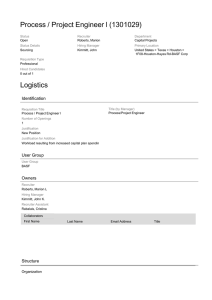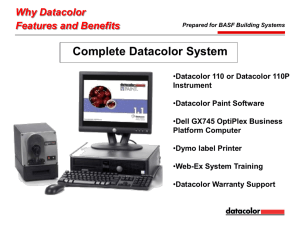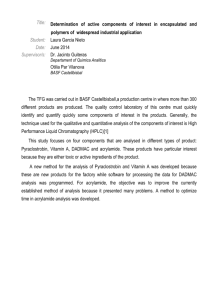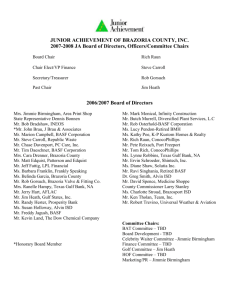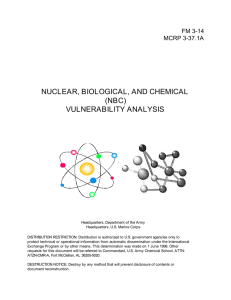Air/Water-Resistive Barrier Scores High Marks
advertisement
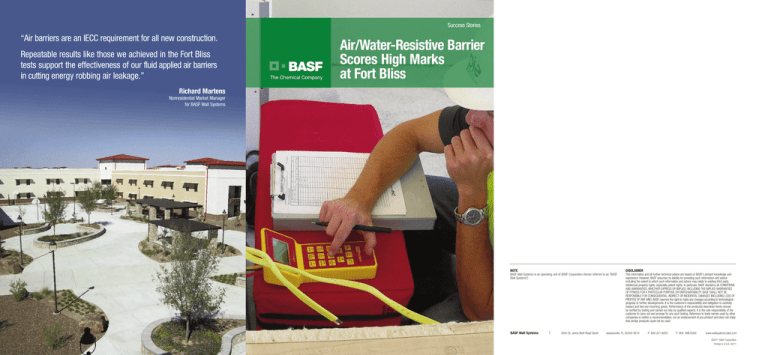
Success Stories “Air barriers are an IECC requirement for all new construction. Repeatable results like those we achieved in the Fort Bliss tests support the effectiveness of our fluid applied air barriers in cutting energy robbing air leakage.” Air/Water-Resistive Barrier Scores High Marks at Fort Bliss Richard Martens Nonresidential Market Manager for BASF Wall Systems NOTE DISCLAIMER BASF Wall Systems is an operating unit of BASF Corporation (herein referred to as “BASF Wall Systems”) This information and all further technical advice are based on BASF’s present knowledge and experience. However, BASF assumes no liability for providing such information and advice including the extent to which such information and advice may relate to existing third party intellectual property rights, especially patent rights. In particular, BASF disclaims all CONDITIONS AND WARRANTIES, WHETHER EXPRESS OR IMPLIED, INCLUDING THE IMPLIED WARRANTIES OF FITNESS FOR A PARTICULAR PURPOSE OR MERCHANTABILITY. BASF SHALL NOT BE RESPONSIBLE FOR CONSEQUENTIAL, INDIRECT OR INCIDENTAL DAMAGES (INCLUDING LOSS OF PROFITS) OF ANY KIND. BASF reserves the right to make any changes according to technological progress or further developments. It is the customer’s responsibility and obligation to carefully inspect and test any incoming goods. Performance of the product(s) described herein should be verified by testing and carried out only by qualified experts. It is the sole responsibility of the customer to carry out and arrange for any such testing. Reference to trade names used by other companies is neither a recommendation, nor an endorsement of any product and does not imply that similar products could not be used. BASF Wall Systems | 3550 St. Johns Bluff Road South Jacksonville, FL 32224-2614 P: 800.221.9255 F: 904. 996.6300 www.wallsystems.basf.com ©2011 BASF Corporation Printed in U.S.A. 02/11 Air / water-resistive barrier is SIX TIMES more effective than the allowable standard Results & Repeatability Multi-point pressure and flow readings were accomplished between 75 Pa and 40 Pa utilizing digital instrumentation per the US Army Corps protocol. Performance cited for repeatability on 24 buildings at Fort Bliss No Room for Error In November 2010 BASF Wall Systems announced the results of third party documented real life performance testing of its air and water-resistive barriers. It’s fluid-applied barrier demonstrated outstanding air tightness performance during fan pressurization/ depressurization testing conducted on new barracks buildings recently constructed at the Fort Bliss, Texas, U.S. Army base. The subcontractor for the Senershield-R and Senerflex EIFS was Diversified Interiors of El Paso. They were already familiar with Senershield-R and had installed many Senergy wall systems in the past. However, Fort Bliss was an unusually large and complex project. According to Blake Anderson, project manager for Diversified Interiors, “the production schedule was tight and required us to complete more than two buildings every month. Completion of the Senershield-R air barriers was on the critical path to get the buildings tight and enclosed. With the requirement for fan pressurization testing on each building, we could not afford any surprises, mistakes or delays.” The Air Tightness Directive The project, which began in August 2009, consists of 24 Infantry Brigade Combat Team UEPH (unaccompanied enlisted personnel housing) barracks for the Army’s 4th and 5th Brigades. Construction of this project was among the very first to fall under the new U.S. Army Corps of Engineer requirement mandating a maximum allowable envelope air leakage of 0.25 cfm/ft² at 75-Pa so as to reduce energy consumed by buildings on bases. On Oct. 30, 2009, the United States Army Corps of Engineers (USACE) issued Engineering and Construction Bulletin No. 2009-29, a Directive defining building air tightness requirements for new construction and for the renovation of existing structures greater than or equal to 25-percent of the total replacement cost of the building beginning in 2010. This Directive references a number of applicable ASTM references, as well as the U.S. Army Corps of Engineers Air Leakage Test Protocol for Measuring Air Leakage in Buildings. To address these concerns, he worked with a BASF Wall Systems team who augmented internet video application demonstrations with additional on-site applicator training for his crews. Anderson explained: “Even experienced crews benefit from reviewing critical application details with the manufacturer’s technical representative – especially when air leakage tests could mean a huge loss of time and money if application were done improperly.” Building Description Testing was accomplished with adaptable rigid door panel frames and high powered fan systems. Based on the maximum allowable passing fan flow (CFM) for the barracks, Pie Forensic Consultants was prepared with 3 fan systems for all tests. However, due to the overall tightness of the air barrier only 1 fan system was needed to reach 75 Pa (+ and -) during testing on all buildings. Each of the Ft. Bliss UEPH barracks is a two-story building with a “U” shaped layout and a building envelope area of 71,312 ft² (the surface area of the defined air barrier). The exterior envelope walls consist of plywood sheathing over wood framing. Senershield-R fluid air/water-resistive barrier and accessory flashing tapes were selected for application over the sheathed walls. The design also specified a mixed exterior cladding consisting of BASF Wall Systems Senerflex Channeled Adhesive Design EIFS with a concrete masonry unit split face wainscot. The floors are poured concrete slabs and the roof assemblies are a fully adhered thermoplastic-olefin (TPO) single ply membrane. Although they spray-applied Senershield-R on other projects, Diversified chose roller application based upon project layout and site conditions. Large mock ups showing all critical details were prepared on site with the guidance of a BASF representative. Blake Anderson Project manager for Diversified Interiors In addition to training and mock ups, the general contractor, Sundt Construction, arranged for a pre-construction conference involving their air barrier consultant and testing firm, Pie Forensic Consultants along with Diversified Interiors, other subcontractors and a representative of the Army Corps of Engineers. Blake Anderson said, “These meetings provided an opportunity to inspect the mock-ups, and review details, sequencing and jobsite safety issues.” Pie Forensic Consultants conducted the first building performance testing and diagnostic evaluations of one of these UEPH barracks on April 14, 2010; subsequently, Pie has tested all 24 UEPH barracks for the project. All 24 of the UEPH’s not only passed during the first round of testing, but far surpassed the U.S. Army Corps of Engineers requirement. Summary of Test Results of the 24 UEPHs Ft. Bliss IBCT 1 & 2 UEPH’s - Air Leakage (cfm/ft2) Summary for 24 UEPH’s % Better than 0.25 cfm/ft2 USACE Requirement Average (for all 24 UEPH’s tested) 0.07 71% Maximum (from all 24 UEPH’s tested) 0.10 60% Minimum (from all 24 UEPH’s tested) 0.05 81% Eric Amhaus, a Principal with Pie Forensic Consultants stated; “Not only have all of the buildings passed with flying colors, but the repeatability of the performance testing results on this project were outstanding. The fact that the test results for all 24 UEPHs have been so close, indicates that similar results can be achieved on other buildings with like construction, materials and attention to detail in both the design and construction phases. This data can be used by the U.S. Army and/or others when evaluating design parameters & defining expected levels of performance for future buildings”. Amhaus further added, “It should also not be overlooked that the 0.25 cfm/ft² US Army Corps requirement is approximately 38 percent tighter or more demanding than ASHRAE 189.1, which is to be adopted in the 2012 International Energy Conservation Code and sets the maximum allowable whole building leakage for commercial buildings at 0.40 cfm/ft². Sundt Construction and all of the parties involved on this project should be proud of what they have achieved.” Pie Forensic Consultants observed repeatability in the test results on all 24 buildings; each passed the test the first time and with very consistent results, well under the maximum allowable leakage rates. Performance testing showed that the incorporation of Senershield-R as the primary vertical wall air barrier on this project contributed to the client achieving average air leakage rates that were 71 percent better than the U.S. Army Corps of Engineers’ maximum allowable requirement of 0.25 cfm/ft² at 75-Pa. According to Richard Martens, Nonresidential Market Manager for BASF Wall Systems, the growth in the use of air barriers is increasing rapidly. “Air barriers are an IECC requirement for all new construction. Repeatable results like those we achieved in the Fort Bliss tests support the effectiveness of our fluid applied air barriers in cutting energy robbing air leakage.” Air leakage diagnostics were accomplished as a part of each test by Pie Forensic Consultants’ certified infrared thermographers. Air / water-resistive barrier is SIX TIMES more effective than the allowable standard Results & Repeatability Multi-point pressure and flow readings were accomplished between 75 Pa and 40 Pa utilizing digital instrumentation per the US Army Corps protocol. Performance cited for repeatability on 24 buildings at Fort Bliss No Room for Error In November 2010 BASF Wall Systems announced the results of third party documented real life performance testing of its air and water-resistive barriers. It’s fluid-applied barrier demonstrated outstanding air tightness performance during fan pressurization/ depressurization testing conducted on new barracks buildings recently constructed at the Fort Bliss, Texas, U.S. Army base. The subcontractor for the Senershield-R and Senerflex EIFS was Diversified Interiors of El Paso. They were already familiar with Senershield-R and had installed many Senergy wall systems in the past. However, Fort Bliss was an unusually large and complex project. According to Blake Anderson, project manager for Diversified Interiors, “the production schedule was tight and required us to complete more than two buildings every month. Completion of the Senershield-R air barriers was on the critical path to get the buildings tight and enclosed. With the requirement for fan pressurization testing on each building, we could not afford any surprises, mistakes or delays.” The Air Tightness Directive The project, which began in August 2009, consists of 24 Infantry Brigade Combat Team UEPH (unaccompanied enlisted personnel housing) barracks for the Army’s 4th and 5th Brigades. Construction of this project was among the very first to fall under the new U.S. Army Corps of Engineer requirement mandating a maximum allowable envelope air leakage of 0.25 cfm/ft² at 75-Pa so as to reduce energy consumed by buildings on bases. On Oct. 30, 2009, the United States Army Corps of Engineers (USACE) issued Engineering and Construction Bulletin No. 2009-29, a Directive defining building air tightness requirements for new construction and for the renovation of existing structures greater than or equal to 25-percent of the total replacement cost of the building beginning in 2010. This Directive references a number of applicable ASTM references, as well as the U.S. Army Corps of Engineers Air Leakage Test Protocol for Measuring Air Leakage in Buildings. To address these concerns, he worked with a BASF Wall Systems team who augmented internet video application demonstrations with additional on-site applicator training for his crews. Anderson explained: “Even experienced crews benefit from reviewing critical application details with the manufacturer’s technical representative – especially when air leakage tests could mean a huge loss of time and money if application were done improperly.” Building Description Testing was accomplished with adaptable rigid door panel frames and high powered fan systems. Based on the maximum allowable passing fan flow (CFM) for the barracks, Pie Forensic Consultants was prepared with 3 fan systems for all tests. However, due to the overall tightness of the air barrier only 1 fan system was needed to reach 75 Pa (+ and -) during testing on all buildings. Each of the Ft. Bliss UEPH barracks is a two-story building with a “U” shaped layout and a building envelope area of 71,312 ft² (the surface area of the defined air barrier). The exterior envelope walls consist of plywood sheathing over wood framing. Senershield-R fluid air/water-resistive barrier and accessory flashing tapes were selected for application over the sheathed walls. The design also specified a mixed exterior cladding consisting of BASF Wall Systems Senerflex Channeled Adhesive Design EIFS with a concrete masonry unit split face wainscot. The floors are poured concrete slabs and the roof assemblies are a fully adhered thermoplastic-olefin (TPO) single ply membrane. Although they spray-applied Senershield-R on other projects, Diversified chose roller application based upon project layout and site conditions. Large mock ups showing all critical details were prepared on site with the guidance of a BASF representative. Blake Anderson Project manager for Diversified Interiors In addition to training and mock ups, the general contractor, Sundt Construction, arranged for a pre-construction conference involving their air barrier consultant and testing firm, Pie Forensic Consultants along with Diversified Interiors, other subcontractors and a representative of the Army Corps of Engineers. Blake Anderson said, “These meetings provided an opportunity to inspect the mock-ups, and review details, sequencing and jobsite safety issues.” Pie Forensic Consultants conducted the first building performance testing and diagnostic evaluations of one of these UEPH barracks on April 14, 2010; subsequently, Pie has tested all 24 UEPH barracks for the project. All 24 of the UEPH’s not only passed during the first round of testing, but far surpassed the U.S. Army Corps of Engineers requirement. Summary of Test Results of the 24 UEPHs Ft. Bliss IBCT 1 & 2 UEPH’s - Air Leakage (cfm/ft2) Summary for 24 UEPH’s % Better than 0.25 cfm/ft2 USACE Requirement Average (for all 24 UEPH’s tested) 0.07 71% Maximum (from all 24 UEPH’s tested) 0.10 60% Minimum (from all 24 UEPH’s tested) 0.05 81% Eric Amhaus, a Principal with Pie Forensic Consultants stated; “Not only have all of the buildings passed with flying colors, but the repeatability of the performance testing results on this project were outstanding. The fact that the test results for all 24 UEPHs have been so close, indicates that similar results can be achieved on other buildings with like construction, materials and attention to detail in both the design and construction phases. This data can be used by the U.S. Army and/or others when evaluating design parameters & defining expected levels of performance for future buildings”. Amhaus further added, “It should also not be overlooked that the 0.25 cfm/ft² US Army Corps requirement is approximately 38 percent tighter or more demanding than ASHRAE 189.1, which is to be adopted in the 2012 International Energy Conservation Code and sets the maximum allowable whole building leakage for commercial buildings at 0.40 cfm/ft². Sundt Construction and all of the parties involved on this project should be proud of what they have achieved.” Pie Forensic Consultants observed repeatability in the test results on all 24 buildings; each passed the test the first time and with very consistent results, well under the maximum allowable leakage rates. Performance testing showed that the incorporation of Senershield-R as the primary vertical wall air barrier on this project contributed to the client achieving average air leakage rates that were 71 percent better than the U.S. Army Corps of Engineers’ maximum allowable requirement of 0.25 cfm/ft² at 75-Pa. According to Richard Martens, Nonresidential Market Manager for BASF Wall Systems, the growth in the use of air barriers is increasing rapidly. “Air barriers are an IECC requirement for all new construction. Repeatable results like those we achieved in the Fort Bliss tests support the effectiveness of our fluid applied air barriers in cutting energy robbing air leakage.” Air leakage diagnostics were accomplished as a part of each test by Pie Forensic Consultants’ certified infrared thermographers. Air / water-resistive barrier is SIX TIMES more effective than the allowable standard Results & Repeatability Multi-point pressure and flow readings were accomplished between 75 Pa and 40 Pa utilizing digital instrumentation per the US Army Corps protocol. Performance cited for repeatability on 24 buildings at Fort Bliss No Room for Error In November 2010 BASF Wall Systems announced the results of third party documented real life performance testing of its air and water-resistive barriers. It’s fluid-applied barrier demonstrated outstanding air tightness performance during fan pressurization/ depressurization testing conducted on new barracks buildings recently constructed at the Fort Bliss, Texas, U.S. Army base. The subcontractor for the Senershield-R and Senerflex EIFS was Diversified Interiors of El Paso. They were already familiar with Senershield-R and had installed many Senergy wall systems in the past. However, Fort Bliss was an unusually large and complex project. According to Blake Anderson, project manager for Diversified Interiors, “the production schedule was tight and required us to complete more than two buildings every month. Completion of the Senershield-R air barriers was on the critical path to get the buildings tight and enclosed. With the requirement for fan pressurization testing on each building, we could not afford any surprises, mistakes or delays.” The Air Tightness Directive The project, which began in August 2009, consists of 24 Infantry Brigade Combat Team UEPH (unaccompanied enlisted personnel housing) barracks for the Army’s 4th and 5th Brigades. Construction of this project was among the very first to fall under the new U.S. Army Corps of Engineer requirement mandating a maximum allowable envelope air leakage of 0.25 cfm/ft² at 75-Pa so as to reduce energy consumed by buildings on bases. On Oct. 30, 2009, the United States Army Corps of Engineers (USACE) issued Engineering and Construction Bulletin No. 2009-29, a Directive defining building air tightness requirements for new construction and for the renovation of existing structures greater than or equal to 25-percent of the total replacement cost of the building beginning in 2010. This Directive references a number of applicable ASTM references, as well as the U.S. Army Corps of Engineers Air Leakage Test Protocol for Measuring Air Leakage in Buildings. To address these concerns, he worked with a BASF Wall Systems team who augmented internet video application demonstrations with additional on-site applicator training for his crews. Anderson explained: “Even experienced crews benefit from reviewing critical application details with the manufacturer’s technical representative – especially when air leakage tests could mean a huge loss of time and money if application were done improperly.” Building Description Testing was accomplished with adaptable rigid door panel frames and high powered fan systems. Based on the maximum allowable passing fan flow (CFM) for the barracks, Pie Forensic Consultants was prepared with 3 fan systems for all tests. However, due to the overall tightness of the air barrier only 1 fan system was needed to reach 75 Pa (+ and -) during testing on all buildings. Each of the Ft. Bliss UEPH barracks is a two-story building with a “U” shaped layout and a building envelope area of 71,312 ft² (the surface area of the defined air barrier). The exterior envelope walls consist of plywood sheathing over wood framing. Senershield-R fluid air/water-resistive barrier and accessory flashing tapes were selected for application over the sheathed walls. The design also specified a mixed exterior cladding consisting of BASF Wall Systems Senerflex Channeled Adhesive Design EIFS with a concrete masonry unit split face wainscot. The floors are poured concrete slabs and the roof assemblies are a fully adhered thermoplastic-olefin (TPO) single ply membrane. Although they spray-applied Senershield-R on other projects, Diversified chose roller application based upon project layout and site conditions. Large mock ups showing all critical details were prepared on site with the guidance of a BASF representative. Blake Anderson Project manager for Diversified Interiors In addition to training and mock ups, the general contractor, Sundt Construction, arranged for a pre-construction conference involving their air barrier consultant and testing firm, Pie Forensic Consultants along with Diversified Interiors, other subcontractors and a representative of the Army Corps of Engineers. Blake Anderson said, “These meetings provided an opportunity to inspect the mock-ups, and review details, sequencing and jobsite safety issues.” Pie Forensic Consultants conducted the first building performance testing and diagnostic evaluations of one of these UEPH barracks on April 14, 2010; subsequently, Pie has tested all 24 UEPH barracks for the project. All 24 of the UEPH’s not only passed during the first round of testing, but far surpassed the U.S. Army Corps of Engineers requirement. Summary of Test Results of the 24 UEPHs Ft. Bliss IBCT 1 & 2 UEPH’s - Air Leakage (cfm/ft2) Summary for 24 UEPH’s % Better than 0.25 cfm/ft2 USACE Requirement Average (for all 24 UEPH’s tested) 0.07 71% Maximum (from all 24 UEPH’s tested) 0.10 60% Minimum (from all 24 UEPH’s tested) 0.05 81% Eric Amhaus, a Principal with Pie Forensic Consultants stated; “Not only have all of the buildings passed with flying colors, but the repeatability of the performance testing results on this project were outstanding. The fact that the test results for all 24 UEPHs have been so close, indicates that similar results can be achieved on other buildings with like construction, materials and attention to detail in both the design and construction phases. This data can be used by the U.S. Army and/or others when evaluating design parameters & defining expected levels of performance for future buildings”. Amhaus further added, “It should also not be overlooked that the 0.25 cfm/ft² US Army Corps requirement is approximately 38 percent tighter or more demanding than ASHRAE 189.1, which is to be adopted in the 2012 International Energy Conservation Code and sets the maximum allowable whole building leakage for commercial buildings at 0.40 cfm/ft². Sundt Construction and all of the parties involved on this project should be proud of what they have achieved.” Pie Forensic Consultants observed repeatability in the test results on all 24 buildings; each passed the test the first time and with very consistent results, well under the maximum allowable leakage rates. Performance testing showed that the incorporation of Senershield-R as the primary vertical wall air barrier on this project contributed to the client achieving average air leakage rates that were 71 percent better than the U.S. Army Corps of Engineers’ maximum allowable requirement of 0.25 cfm/ft² at 75-Pa. According to Richard Martens, Nonresidential Market Manager for BASF Wall Systems, the growth in the use of air barriers is increasing rapidly. “Air barriers are an IECC requirement for all new construction. Repeatable results like those we achieved in the Fort Bliss tests support the effectiveness of our fluid applied air barriers in cutting energy robbing air leakage.” Air leakage diagnostics were accomplished as a part of each test by Pie Forensic Consultants’ certified infrared thermographers. Success Stories “Air barriers are an IECC requirement for all new construction. Repeatable results like those we achieved in the Fort Bliss tests support the effectiveness of our fluid applied air barriers in cutting energy robbing air leakage.” Air/Water-Resistive Barrier Scores High Marks at Fort Bliss Richard Martens Nonresidential Market Manager for BASF Wall Systems NOTE DISCLAIMER BASF Wall Systems is an operating unit of BASF Corporation (herein referred to as “BASF Wall Systems”) This information and all further technical advice are based on BASF’s present knowledge and experience. However, BASF assumes no liability for providing such information and advice including the extent to which such information and advice may relate to existing third party intellectual property rights, especially patent rights. In particular, BASF disclaims all CONDITIONS AND WARRANTIES, WHETHER EXPRESS OR IMPLIED, INCLUDING THE IMPLIED WARRANTIES OF FITNESS FOR A PARTICULAR PURPOSE OR MERCHANTABILITY. BASF SHALL NOT BE RESPONSIBLE FOR CONSEQUENTIAL, INDIRECT OR INCIDENTAL DAMAGES (INCLUDING LOSS OF PROFITS) OF ANY KIND. BASF reserves the right to make any changes according to technological progress or further developments. It is the customer’s responsibility and obligation to carefully inspect and test any incoming goods. Performance of the product(s) described herein should be verified by testing and carried out only by qualified experts. It is the sole responsibility of the customer to carry out and arrange for any such testing. Reference to trade names used by other companies is neither a recommendation, nor an endorsement of any product and does not imply that similar products could not be used. BASF Wall Systems | 3550 St. Johns Bluff Road South Jacksonville, FL 32224-2614 P: 800.221.9255 F: 904. 996.6300 www.wallsystems.basf.com ©2011 BASF Corporation Printed in U.S.A. 02/11 Success Stories “Air barriers are an IECC requirement for all new construction. Repeatable results like those we achieved in the Fort Bliss tests support the effectiveness of our fluid applied air barriers in cutting energy robbing air leakage.” Air/Water-Resistive Barrier Scores High Marks at Fort Bliss Richard Martens Nonresidential Market Manager for BASF Wall Systems NOTE DISCLAIMER BASF Wall Systems is an operating unit of BASF Corporation (herein referred to as “BASF Wall Systems”) This information and all further technical advice are based on BASF’s present knowledge and experience. However, BASF assumes no liability for providing such information and advice including the extent to which such information and advice may relate to existing third party intellectual property rights, especially patent rights. In particular, BASF disclaims all CONDITIONS AND WARRANTIES, WHETHER EXPRESS OR IMPLIED, INCLUDING THE IMPLIED WARRANTIES OF FITNESS FOR A PARTICULAR PURPOSE OR MERCHANTABILITY. BASF SHALL NOT BE RESPONSIBLE FOR CONSEQUENTIAL, INDIRECT OR INCIDENTAL DAMAGES (INCLUDING LOSS OF PROFITS) OF ANY KIND. BASF reserves the right to make any changes according to technological progress or further developments. It is the customer’s responsibility and obligation to carefully inspect and test any incoming goods. Performance of the product(s) described herein should be verified by testing and carried out only by qualified experts. It is the sole responsibility of the customer to carry out and arrange for any such testing. Reference to trade names used by other companies is neither a recommendation, nor an endorsement of any product and does not imply that similar products could not be used. BASF Wall Systems | 3550 St. Johns Bluff Road South Jacksonville, FL 32224-2614 P: 800.221.9255 F: 904. 996.6300 www.wallsystems.basf.com ©2011 BASF Corporation Printed in U.S.A. 02/11
